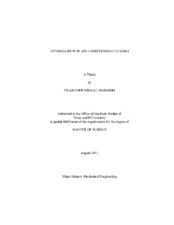| dc.description.abstract | Systems based on the vapor compression cycle are the most widely used in a variety of air conditioning applications. Despite the vast growth of modern control systems in the field of air conditioning systems, industry standard control is still thermostat based on-off control, in other words cycle control. This thesis proposes an approach to find the optimal profiles for the expansion valve and the evaporator fan for an air conditioning system for a given period of on-off cycle of the compressor. The research will consist of two phases, the development of a simulation model and an experimental analysis.
In this thesis, the profiles for the expansion valve and the evaporator fan are parameterized by an S-curve equation so that the optimization problem will have less numbers of parameters. The first step is a simulation model that predicts startup/shutdown characteristics. This model is used as a tool to understand the effect that the S-curve parameters has on the system cycle efficiency. Several key vapor compression system dynamics are identified as causes for increasing/decreasing system's cyclic efficiency. Refrigerant migration and fan delay at shutdown are determined as crucial issues that have an effect on the A direct search optimization algorithm, namely the simplex search algorithm, is then used to search for the optimal S-curve parameters. Valve/fan strategies that ultimately resulted in a better superheat control are assessed as the most energy efficient. Extensive experimental tests conducted on a 3-ton residential air conditioner are then presented to intuitively understand the effect of expansion valve and evaporator fan cycling in a real system. A real time optimization method is explored and the feasibility, recommendations for a successful online method are proposed. The heuristics for the expansion valve and evaporator fan profiles from the optimization results could be easily hard coded into any commercial air conditioning system to perform the much preferred cycle control. Thus a significant improvement in the energy performance was observed without the use of any advanced control techniques. | en |


